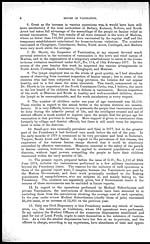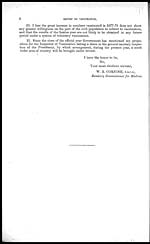Medicine - Vaccination > 1877-1929 - Report on vaccination in the Madras Presidency > Report on vaccination in Madras 1877-1894 > 1877-1878 - Report on vaccination throughout the Presidency and Provinces of Madras, for the year 1877-78
(13) Page 5
Download files
Individual page:
Thumbnail gallery: Grid view | List view

REPORT ON VACCINATION. 5
tunities of vaccinating. By utilising the services of their medical servants, the
Local Fund Boards might get more vaccine work done, and the Taluk Vaccinators
might devote their energies mainly to outlying villages and hamlets, which are now
to a great extent neglected.
14. In regard to the results of the vaccination work the tables, prepared
according to the new forms of the Government of India, show a total of 787,146
persons vaccinated, of which number 776,705 were primary vaccinations and
11,025 re-vaccinations. Of the former 648,097 or 82.28 per cent. were returned as
" successful," and of the re-vaccination cases 7,210 or 65.39 per cent. succeeded.
The proportion of success would have been higher in primary vaccinations, only
that during the famine crisis many persons subjected to the operation were lost
sight of, and such persons could not be entered as those successfully operated on.
15. The following abstract shows the agency by which the vaccine operations
were carried out:—
|
Numbers. |
|
|
Vaccine circles, including Madras District ... ... ... |
685,890 |
|
Provincial Municipalities ... ... ... ... ... ... |
59,288 |
|
Dispensaries ... ... ... ... ... ... ... ... |
584 |
|
By Medical Subordinates (chiefly in jails) ... ... ... |
28,584 |
|
Military Cantonments beyond Presidency ... ... ... |
6,790 |
|
Private Vaccinators ... ... ... ... ... ... ... |
471 |
|
Private Estate Vaccinators ... ... ... ... ... |
6,113 |
|
Railway Apothecaries ... ... ... ... ... ... |
10 |
|
Total ... |
787,730 |
16. In the classification adopted in the report the work of the Madras Collec-
torate has been included under Circles and Districts, whereas it should properly
have been shown under " Municipalities," as the Municipal exchequer pays all
costs, beyond that of the Vaccine Depôt, maintained at the Presidency town.
In future reports the necessary corrections will be made. Practically during the
last year the vaccination in the Presidency town partook of a provincial character
owing to the flocking in of many thousands of destitute people from other districts.
17. In regard to the expenses of vaccination, the following abstract shows the
total cost and sources of payment:—
|
RS. |
A. |
P. |
|
|
Imperial ... ... ... ... ... ... ... |
1,212 |
10 |
0 |
|
Provincial ... ... ... ... ... ... |
24,434 |
0 |
8 |
|
Local ... ... ... ... ... ... ... |
1,05,630 |
13 |
7 |
|
Municipal... ... ... ... ... ... |
17,491 |
3 |
1 |
|
Private contribution from Zemindars or Estate owners. |
1,491 |
9 |
11 |
|
Total ... |
1,50,330 |
5 |
3 |
18. The cost per head, excluding the work of Medical Subordinates and private
Vaccinators, was 3 Annas 9 Pies against 4 Annas 10 Pies in 1876-77. The amount
varied from 12 Annas 5 Pies in Kurnool District to 1 Anna 6 Pies in South Coimba-
tore Circle. The collection of the people in relief centres facilitated vaccination
work and diminished cost. But there seems no good reason why, year after year,
the amount of vaccine work in Kurnool should be so disproportionate to cost, and I
would suggest that the attention of the Local Fund Board should be drawn to the
scanty numbers vaccinated in the district.
19. In the next few years there will be fewer subjects generally available for
vaccination. The mortality of the famine has, as shown by the Census results,
fallen heavily on the children under 10 years of age, and birth-rates have been
exceedingly low for many months past. Whilst recently inspecting in Coimbatore
the Vaccinators complained to me that they had great difficulty in finding unvaccin-
ated children so as to keep up their usual numbers.
2
Set display mode to: Large image | Zoom image | Transcription
Images and transcriptions on this page, including medium image downloads, may be used under the Creative Commons Attribution 4.0 International Licence unless otherwise stated. ![]()
| Permanent URL | https://digital.nls.uk/91174313 |
|---|
| Attribution and copyright: |
|
|---|




